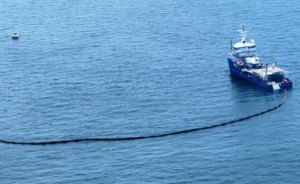US military joins Gulf of Mexico oil spill effort
 The US military has joined efforts to stop an oil leak in the Gulf of Mexico as fears rise about its scale.
The US military has joined efforts to stop an oil leak in the Gulf of Mexico as fears rise about its scale.Five times as much oil as previously thought could be leaking from the well beneath where a rig exploded and sank last week, the US Coast Guard says.
Rear Admiral Mary Landry said 5,000 barrels a day were thought to be gushing into the sea off Louisiana.
The Department of Homeland Security has designated the spill as one of “national significance”.
Homeland Security Secretary Janet Napolitano, who is to go to Louisiana to oversee operations, told reporters in Washington that this designation would allow resources to be ordered in from other areas of the US.
At the same briefing, a coastguard official said the oil slick was expected to wash ashore on the Gulf Coast on Friday.
And Deputy Secretary of the Department of the Interior David Hayes said the US government had ordered inspections of all deep-water oil wells in the Gulf of Mexico to see if anti-spill regulations were being followed.
The oil slick caused by the leak is 45 miles by 105 miles and is heading towards the coast.
If the coastguard estimate is correct, within two months the spill could match the 11 million gallons spilt from the Exxon Valdez tanker off Alaska in 1989.
Oil giant BP operated the Deepwater Horizon rig. Its chief operating officer of exploration and production, Doug Suttles, welcomed the US military’s offer of help.
He said the company was using remote operative vehicles (ROVs) to try to find out how much oil was leaking into the sea.
“This is very, very difficult to estimate,” Mr Suttles told reporters.
“Down below the surface we actually can’t meter this oil so we can just observe it… what our ROV pictures show to us on the sea floor hasn’t changed since we first saw the leak… but what we can say based on what we’re picking up on the surface it looks like it is more.”
Mr Suttles estimated something between 1,000 and 5,000 barrels a day was leaking.
Meanwhile, a firefighting expert said the disaster may become the biggest oil spill ever.
Mike Miller, head of Canadian oil well firefighting company Safety Boss, told the BBC World Service: “Probably the only thing comparable to this is the Kuwait fires [following the Gulf War in 1991].
“The Exxon Valdez is going to pale in comparison to this as it goes on.”
Scientists say only a quarter of local marine wildlife survived the Exxon Valdez disaster.
Controlled burn
The scale of the operation to contain the oil spill and protect both the US coastline and wildlife is unprecedented, with the military and other government agencies collaborating with BP - which had hired the sunken rig - and industry leaders.
Efforts to stem the flow are being complicated by the depth of the leak at the underwater well, which is about 5,000ft (1,525m) beneath the surface.
A coastguard crew has set fire to part of the oil slick in an attempt to save environmentally-fragile wetlands.
A “controlled burn” of surface oil took place in an area about 30 miles (50km) east of the Mississippi River delta.
But Mr Miller warned that burning off leaking oil was not a long-term solution.
“The object of this game is to shut off the flow,” he said.
Relief well
Engineers are working on a dome-like device to cover oil rising to the surface and pump it to container vessels, but it may be weeks before this is in place.
It is feared that work on sealing the leaking well using robotic submersibles might take months.
BP is also working on a “relief well” to intersect the original well, but this is experimental and could take two to three months to stop the flow.
Seventy vessels - oil skimmers, tugboats barges and special recovery boats that separate oil from water - as well as five aeroplanes, were working to spray dispersants and round up oil, BP said.
Eleven workers are missing and presumed dead after the worst oil rig disaster in almost a decade.
Louisiana’s coast contains some 40% of the nation’s wetlands and spawning grounds for countless fish and birds.
AFP news agency reports that two Louisiana shrimpers have filed a lawsuit accusing the operators of the rig of negligence, and seeking at least $5m in damages plus undetermined punitive damages.

You can return to the main Market News page, or press the Back button on your browser.

